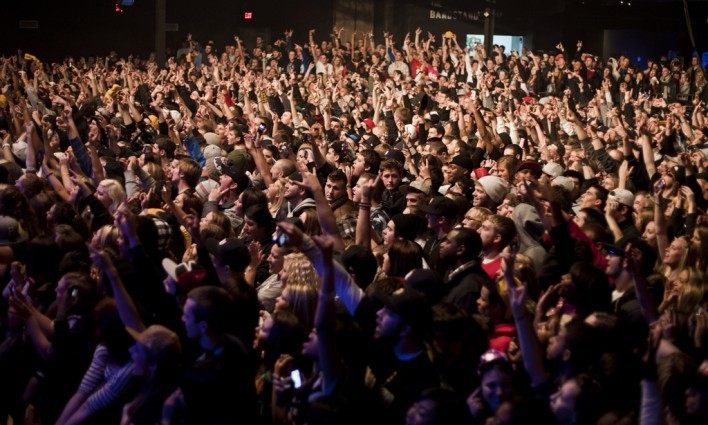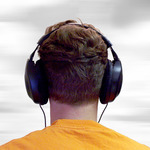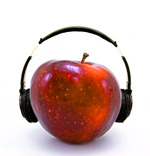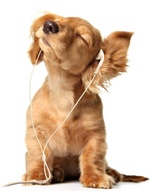Previously, on our binaural recording blog, we started to discuss binaural recording in indie, pop and rock music, and whether or not there is an artistic or commercial place for it. As a lover of A) all things binaural and B) many diverse genres of music, I thought I would add my own two cents to the discussion.
And so, for all you bands out there, I’d like to share the top 5 reasons why binaural recording is actually perfectly suited to indie, pop, and rock music – and why you should be planning to take advantage of it on your next record.
1. Everyone (and their dog) has headphones.
I don’t think I need a statistic to say that never in history have headphones been more prevalent in our culture. And from cheapies at the dollar store, to the earbuds that came with your iPod/iPhone, to the $1000 audiophile models at hi-fi shops, ANY set of stereo headphones will reproduce binaural audio.
On top of that, never has music – pop/indie/rock music especially – been so accessible. People can buy it, download it, stream it, YouTube it, etc from almost anywhere they go, to a device that they use with headphones.
Plus, headphones creep into people’s lives at multiple points of the day – not just for quiet listening, but also for commuting or exercising, which many people do for hours every day (not necessarily in equal proportion, of course!).
Isn’t it time bands created recordings tailored to these common listening habits?
2. Regular stereo is like a Hollywood movie. Binaural audio is a Broadway show on demand.
 When you listen to a band’s single (recorded in normal stereo in a studio), you have to accept that in 99/100 cases, it’s not the way the band really sounds. (The same way you know that you can’t really jump a car through an explosion without a scratch.) The vocals are heavily compressed, the instruments are precisely EQed and processed to sit “perfectly” together, and everything comes at you from across a straight line, panned left to right (two dimensionally). This is “acoustic fiction.”
When you listen to a band’s single (recorded in normal stereo in a studio), you have to accept that in 99/100 cases, it’s not the way the band really sounds. (The same way you know that you can’t really jump a car through an explosion without a scratch.) The vocals are heavily compressed, the instruments are precisely EQed and processed to sit “perfectly” together, and everything comes at you from across a straight line, panned left to right (two dimensionally). This is “acoustic fiction.”
When you hear a live performance though, things are very different. Suddenly, music you’re used to hearing only in recordings is transformed from a quilt of cosmetically “perfected” parts, to a living, breathing entity with you inside it.
Binaural recording captures this incredible live experience and allows listeners to feel like they are right back in the performance any time they want. It turns “acoustic fiction” into “acoustic virtual reality.”
3. It’s unique, but not gimmicky.
 Maybe this is playing to the musical ego, or marketer in the group, but what band doesn’t want to set themselves apart from the vast sea of records out there? Binaural recording does just that. It gives your fans (and the media) something special – something worth sharing.
Maybe this is playing to the musical ego, or marketer in the group, but what band doesn’t want to set themselves apart from the vast sea of records out there? Binaural recording does just that. It gives your fans (and the media) something special – something worth sharing.
The best part, of course, is that we’re not talking about some cheap gimmick or stunt, like stopping freeway traffic to get your band on the news. Instead, binaural recording captures your music in it’s most natural, intimate form.
The hype doesn’t come from the word “3D,” but from the way listeners’ jaws drop when they feel like you’re playing right in front of them.
4. It’s transportive, and gives listeners an experience.
 When your listeners put on headphones and pop on your binaural recording, they are immediately transported to the exact place the session took place – and they’re there with you. As an artist, this gives you a huge new range of options for the way you want your fans to experience your music. Where is it best heard? A bar, or concert hall? What about a church, or out in the woods, or in your living room next to a crackling fire?
When your listeners put on headphones and pop on your binaural recording, they are immediately transported to the exact place the session took place – and they’re there with you. As an artist, this gives you a huge new range of options for the way you want your fans to experience your music. Where is it best heard? A bar, or concert hall? What about a church, or out in the woods, or in your living room next to a crackling fire?
Instead of tracking your music in a dead space and then superimposing artificial reverb (even with state-of-the-art impulse response processors), record it binaurally and the listener can immediately tell what kind of space they’re in – with every detail of instrument placement, height, width, depth and ambient sound preserved.
By recreating the intimacy of a live performance, you bring your fans closer, and bridge the gap between the stage and the CD.
5. It’s healthy.
 Binaural audio is the free range organic produce of the recording industry. It doesn’t rely on harsh chemicals or fertilizers (like heavy EQ or processing) to sound right.
Binaural audio is the free range organic produce of the recording industry. It doesn’t rely on harsh chemicals or fertilizers (like heavy EQ or processing) to sound right.
Most importantly, because the goal is to reproduce a live musical experience (not to have your track sound 0.1 dB louder than the one that played previously on the radio), there’s no need to steamroll the dynamics with compression.
This in turn means that instead of listening to a 4-minute “waveform brick” of constant high sound pressure, your ears can breath easy and enjoy some contrast in dynamics. Good for your ear drums, good for your soul.
Well, there you have it. And now that you’ve read through my ramblings, I’d love to know what you think!
If you’re curious, here’s some more information on how binaural audio works, and more tips for binaural recording in any genre.
ALEX KALL
I’m the owner and head engineer here at Kall Binaural Audio. Aside from my career/love affair with binaural audio recording, I’ve worked as Symphony Nova Scotia’s stage manager and marketing coordinator, and am also a freelance bass player and designer.
